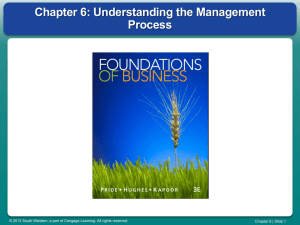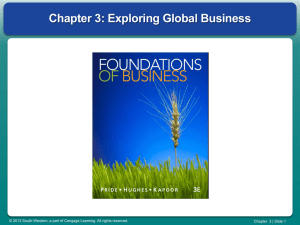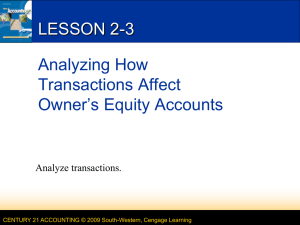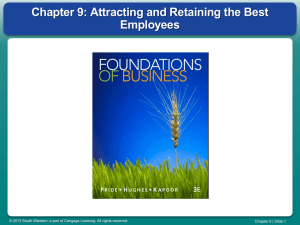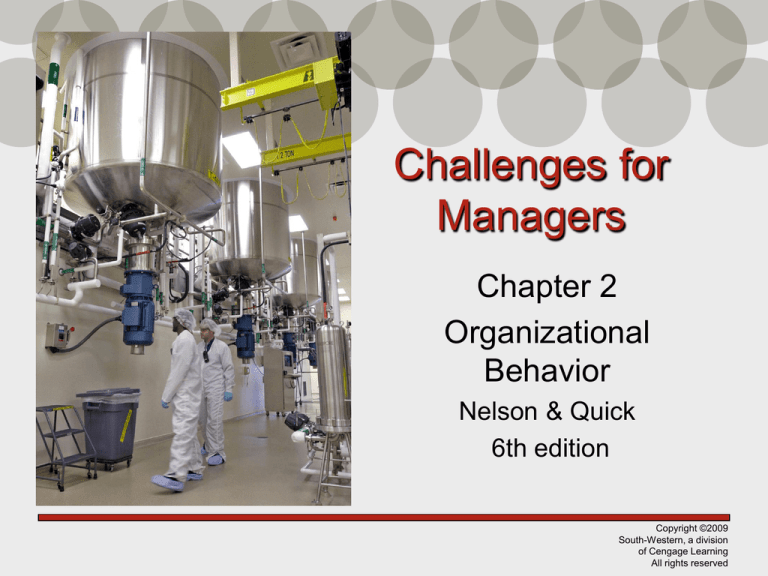
Challenges for
Managers
Chapter 2
Organizational
Behavior
Nelson & Quick
6th edition
Copyright ©2009
South-Western, a division
of Cengage Learning
All rights reserved
Remaining Competitive: Four
Major Challenges to Managers
• Globalizing the firm’s operations
• Leading a diverse workforce
• Encouraging positive ethics,
character, and personal integrity
• Advancing and implementing
technological innovation
Copyright ©2009
South-Western, a division
of Cengage Learning
All rights reserved
Changing Business Perspectives
From International which implies an
individual’s or organization’s
held nationality is strongly
in consciousness
To Globalization which
implies the world is free
from national boundaries and
that it is really a borderless world
Photos courtesy of Clips Online, © 2008 Microsoft Corporation
Copyright ©2009
South-Western, a division
of Cengage Learning
All rights reserved
Changing Business Perspectives
From Multinational organizations
(in which the organization was
recognized as doing business
in several countries)
To Transnational
organizations,
(in which the global viewpoint
supersedes national issues)
Photos courtesy of Clips Online, © 2008 Microsoft Corporation
Copyright ©2009
South-Western, a division
of Cengage Learning
All rights reserved
Changes in the Global
Marketplace
•
•
•
•
Collapse of Eastern Europe
Union of East and West Berlin
Perestroika
Expansion of business with China
Guanxi - The Chinese practice of
building networks for social exchange
• Creation of the European Union
• Establishment of the North American Free
Trade Agreement
Copyright ©2009
South-Western, a division
of Cengage Learning
All rights reserved
Understanding Cultural Differences
(Hofstede)
Collectivism
Individualism
Low power distance
High power distance
High uncertainty avoidance
Low uncertainty avoidance
Masculinity
Long-term orientation
Reprinted with permission of Academy of Management, PO Box 3020, Briar Cliff Manor, NY 10510-8020. Cultural
Constraints in Management Theories (Figure), G. Hofstede, Academy of Management Executive 7, (1993). Reproduced
by permission of the publisher via Copyright Clearance Center, Inc.
Femininity
Short-term orientation
Copyright ©2009
South-Western, a division
of Cengage Learning
All rights reserved
Where the U.S. Stands
Collectivism
Individualism
Individualism
Lowpower
powerdistance
distance
Low
High power distance
High uncertainty avoidance
Lowuncertainty
uncertaintyavoidance
avoidance
Low
Masculinity
Masculinity
Long-term orientation
Reprinted with permission of Academy of Management, PO Box 3020, Briar Cliff Manor, NY 10510-8020. Cultural
Constraints in Management Theories (Figure), G. Hofstede, Academy of Management Executive 7, (1993). Reproduced
by permission of the publisher via Copyright Clearance Center, Inc.
Femininity
Short-term
orientation
Short
term orientation
Copyright ©2009
South-Western, a division
of Cengage Learning
All rights reserved
Management Careers with a
Global Dimension
• Expatriate manager - a manager who works in
a country other than his or her home country
• International executive – an executive whose job
has international scope
Key competencies such managers and executives
need include integrity, insightfulness, risk-taking,
courage to take a stand, and ability to bring out
the best in people.
Copyright ©2009
South-Western, a division
of Cengage Learning
All rights reserved
Developing Cross-Cultural
Sensitivity
•
•
•
•
Use of mentor/protégé relationships
Cultural sensitivity training
Cross-cultural task forces/teams
Global view of human resource functions
•
•
•
•
Planning
Recruitment and Selection
Compensation
Training and Development
Copyright ©2009
South-Western, a division
of Cengage Learning
All rights reserved
Diversity
Diversity - All forms of
individual differences,
including culture, gender,
age, ability, personality,
religious affiliation,
economic class, social
status, military
attachment, and sexual
orientation
Photos courtesy of Clips Online, © 2008 Microsoft Corporation
Copyright ©2009
South-Western, a division
of Cengage Learning
All rights reserved
Diversity Statistics for the
Workplace
5%
11%
14%
68%
Copyright ©2009
South-Western, a division
of Cengage Learning
All rights reserved
Women and Obstacles at Work
Women make up over 60% of the workforce, earn 32%
of all doctorates, 52% of master’s degrees, and 50%
of undergraduate degrees
BUT
Women hold less than 16.4% of Fortune 500 corporate
officer positions, earn 81% of what their male
counterparts do, and encounter the glass ceiling in
the workplace
a transparent barrier that keeps women from
rising above a certain level in organizations
Copyright ©2009
South-Western, a division
of Cengage Learning
All rights reserved
Diversity Statistics Affecting
the Workplace
Age
By 2030, there will be 70,000,000 older
persons. People over 65 will comprise
20% of the population.
Ability
An estimated 50 million disabled live in
the U.S.; their unemployment rate
exceeds 50%.
Copyright ©2009
South-Western, a division
of Cengage Learning
All rights reserved
Diversity’s Benefits & Problems
BENEFITS
• Attracts & retains the best
human talent
PROBLEMS
• Resistance to change
• Improves marketing efforts • Lack of cohesiveness
• Promotes creativity and
innovation
• Communication problems
• Results in better problem
solving
• Interpersonal conflicts
• Enhances organizational
flexibility
• Slowed decision making
Copyright ©2009
South-Western, a division
of Cengage Learning
All rights reserved
Ethical Theories
Consequential
Theory
Rule-Based
Theory
Character
Theory
An ethical theory
that
emphasizes the
consequences or
results
of behavior
An ethical theory
that
emphasizes the
character of the act
Itself rather than its
effects
An ethical theory
that emphasizes
the character,
personal virtues,
and integrity of the
individual
Copyright ©2009
South-Western, a division
of Cengage Learning
All rights reserved
Employee Rights Issues
Computerized
monitoring
Drug testing
Free speech
Downsizing & layoffs
Due process
AIDS in the workplace
Photos courtesy of Clips Online, © 2008 Microsoft Corporation
Copyright ©2009
South-Western, a division
of Cengage Learning
All rights reserved
Sexual Harassment =
Unwanted Sexual Attention
• Gender Harassment - crude
comments; behaviors that
convey hostility toward a
particular gender
• Unwanted Sexual Attention unwanted touching, unwanted
Harassment or
pressure for dates
Potential Romance?
• Sexual Coercion - demands for
sexual favors through jobrelated threats or promises
Photos courtesy of Clips Online, © 2008 Microsoft Corporation
Copyright ©2009
South-Western, a division
of Cengage Learning
All rights reserved
Organizational Justice
Distributive Justice-
Procedural Justice-
fairness of the outcomes
that individuals receive
in an organization
fairness by which the
outcomes are allocated
in an organization
Ex. Companies
in Danger
Ex. Competence
and Skill
vs.
vs.
CEO
Salaries
Race and
Gender
Photos courtesy of Clips Online, © 2008 Microsoft Corporation
Copyright ©2009
South-Western, a division
of Cengage Learning
All rights reserved
Individual & Organizational
Responsibility
Whistle-Blower - an employee who
informs authorities of the wrongdoing
of his or her company or coworkers
Depends on whether or not the
– Public Hero
the whistle-blowing is viewed as
more offensive the wrongdoing.
– Villain
Social Responsibility - the
obligation of an organization to
behave in ethical ways
Copyright ©2009
South-Western, a division
of Cengage Learning
All rights reserved
Rotary Four-Way Test
of What We Think, Say, or Do
1. Is it the TRUTH?
2. Is it FAIR to all concerned?
3. Will it build GOODWILL and better
friendships?
4. Will it be BENEFICIAL to all concerned?
Copyright ©2009
South-Western, a division
of Cengage Learning
All rights reserved
Technological Innovation
Technology
Internetintegrates
computer, cable,
telecommunications
technologies
Robotics use of robots
The intellectual and
Expert System mechanical
computer-based
application using a
processes used by
representation of
human expertise in a
an organization to
specialized field of
transform inputs into knowledge to solve
problems
products or services
that meet
organizational goals
Copyright ©2009
South-Western, a division
of Cengage Learning
All rights reserved
Alternative Work Arrangements
Telecommuting - transmitting work from a
home computer to the office using a modem
Employees gain flexibility, save
the commute to work, enjoy the
comforts of home
Employees have distractions, lack
socialization opportunities, lack
interaction with supervisors, and
identify less with the organization
Copyright ©2009
South-Western, a division
of Cengage Learning
All rights reserved
Additional Alternative Work
Arrangements
Hoteling - employees have mobile file
cabinets/lockers for personal storage; work
spaces are reserved, not assigned
Satellite Offices - large facilities broken into
smaller workplaces near employees’
homes
Virtual Office - people work
anytime, anywhere, with
anyone
Photos courtesy of Clips Online, © 2008 Microsoft Corporation
Copyright ©2009
South-Western, a division
of Cengage Learning
All rights reserved
Technological Change
Requires Managers to
• Develop technical competence to gain workers’
respect
• Focus on helping workers manage the stress of
their work
• Take advantage of the wealth of information
available to motivate, coach, and counsel--not to
control
• Recognize the importance of intellectual property
Copyright ©2009
South-Western, a division
of Cengage Learning
All rights reserved
Help Employees Adjust by
• Involving them in decision making
regarding technological change
• Selecting technology that
increases workers’ skill
requirements
• Providing effective training
• Establishing support groups
• Encouraging reinvention (creative application
of new technology)
Photos courtesy of Clips Online, © 2008 Microsoft Corporation
Copyright ©2009
South-Western, a division
of Cengage Learning
All rights reserved
Four Challenges to Organizations
in the New Millennium
Technological
Innovation
Globalization
Photos courtesy of Clips Online, © 2008 Microsoft Corporation
Workforce
Diversity
Ethics
Copyright ©2009
South-Western, a division
of Cengage Learning
All rights reserved
Chapter 2: Reflect & Discuss
Mr. Baseball Video Clip
What to Watch for and Ask Yourself
• Does Jack Elliot behave as if he had crosscultural training before arriving in Japan?
• Is he culturally sensitive or insensitive?
• What do you propose that Jack Elliot do for the
rest of his time in Japan?
Copyright ©2009
South-Western, a division
of Cengage Learning
All rights reserved

